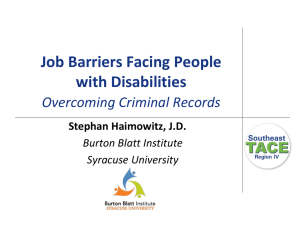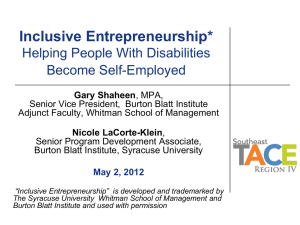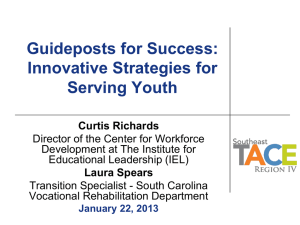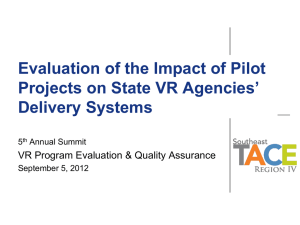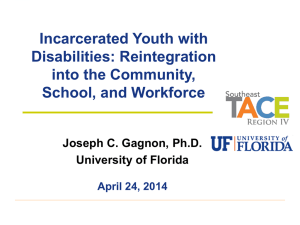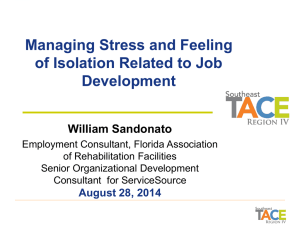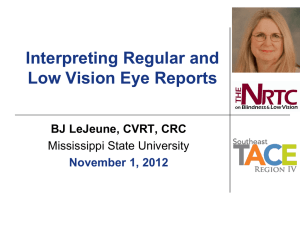Traumatic Brain Injuries (TBI) Coping With Grief
advertisement
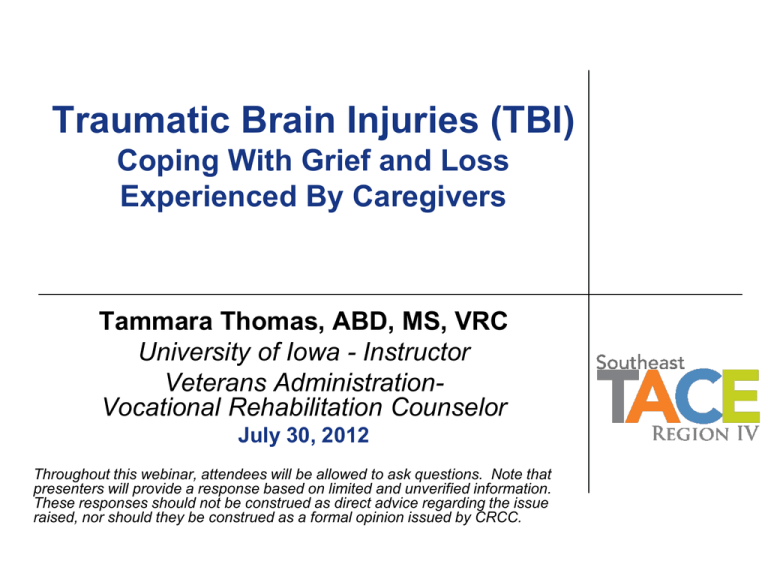
Traumatic Brain Injuries (TBI) Coping With Grief and Loss Experienced By Caregivers Tammara Thomas, ABD, MS, VRC University of Iowa - Instructor Veterans AdministrationVocational Rehabilitation Counselor July 30, 2012 Throughout this webinar, attendees will be allowed to ask questions. Note that presenters will provide a response based on limited and unverified information. These responses should not be construed as direct advice regarding the issue raised, nor should they be construed as a formal opinion issued by CRCC. 2 Objectives • Review of Traumatic Brain Injury and Symptoms • Veteran and TBI • Gain understanding of the impact of TBI on Caregivers • • • and Family Systems Attending from the perspective of grief and loss Introduction of Conceptual Model of Health-related Quality of Life Strategies for families and rehabilitation professionals to assist individuals with TBI TACE Center: Region IV, a project of the Burton Blatt Institute. Funded by RSA Grant # H264A080021. © 2012 3 Traumatic Brain Injury (TBI) defined Department of Defense and the Department of Veteran Affairs (2007) “Any traumatically induced structural injury and/or physiological disruption of the brain function as a result of an external force that is indicated by a new onset or worsening of at least on of the following clinical signs, immediately following the event.” TACE Center: Region IV, a project of the Burton Blatt Institute. Funded by RSA Grant # H264A080021. © 2012 4 5 TBI Diagnosis Criteria 1. Any period of loss of or a decreased level of consciousness; 2. Any loss of memory for events immediately before or after the injury; 3. Any alteration in mental state at the time of the injury; 4. Neurological deficits; 5. Intercranial lesions TACE Center: Region IV, a project of the Burton Blatt Institute. Funded by RSA Grant # H264A080021. © 2012 5 Types of TBI injuries Focal Injury (Open): This is an injury that results from a direct blow to the head (penetrating). The skull is fractured with a blow. The injury can be to a specific area of the brain. Closed Injury: The injury results from a blow or a violent shifting of the brain. The skull isn’t broken, but the brain tissue can be damaged through tearing or shearing. TACE Center: Region IV, a project of the Burton Blatt Institute. Funded by RSA Grant # H264A080021. © 2012 6 Epidemiology of TBI Facts: • TBI is a leading cause of death and disability in the U.S. • • (CDC, 2007) 5.3 million people have enduring disabilities as a direct result of TBI. (CDC, 2007) Estimated costs such as hospital care, lost of productivity (indirect), extended care, and other medical are services were estimated at $60 billion. (Finkelstein, et al., 2006) TACE Center: Region IV, a project of the Burton Blatt Institute. Funded by RSA Grant # H264A080021. © 2012 7 Military TBI The military is calling TBI the “signature injury” of Operation Enduring Freedom and Operation Iraqi Freedom (OEF/OIF). Active Duty timeline is from September 11, 2001-Present. In 2009 there were 1,313 veterans who received VA Inpatient hospital care for TBI. 33% of all patients with combat related injuries and 60% of patients with blast-related injuries seen at Walter Reed Army Medical Center have sustained a TBI. TACE Center: Region IV, a project of the Burton Blatt Institute. Funded by RSA Grant # H264A080021. © 2012 8 Severity of Traumatic Brain Injury (TBI) The severity of TBI is a continuum, and the classification used to designate if a patient has mild, moderate, or severe TBI. The classification is arbitrary because the level of the TBI is not able to predict the patient’s likelihood of functional recovery. TACE Center: Region IV, a project of the Burton Blatt Institute. Funded by RSA Grant # H264A080021. © 2012 9 Severity Grades Severity Grades are defined by using four indexes: 1. The Glasgow Coma Scale (GCS) 2. The length of coma (duration of unconsciousness). 3. Length of period of altered consciousness (mental 4. status) and, Length of posttraumatic amnesia (PTA) TACE Center: Region IV, a project of the Burton Blatt Institute. Funded by RSA Grant # H264A080021. © 2012 10 Types of TBI Closed Head Injury: The blow to the head to leave the skull intact, but the brain shifts within the skull resulting in damage. Open Head Injury: Penetration or fracture of the skull, which may cause more localized damage. TACE Center: Region IV, a project of the Burton Blatt Institute. Funded by RSA Grant # H264A080021. © 2012 11 Brain Injury Measurement of Severity and Classifications MEASUREMENT: GLASCOW COMA SCALE (GCS) Source: White and Likavec (1992) An instrument that has become widely accepted as a classification system for measuring the seriousness of brain injury. (Jenner, Snoek, Bond, & Brooks, 1981). TACE Center: Region IV, a project of the Burton Blatt Institute. Funded by RSA Grant # H264A080021. © 2012 12 The Glascow Coma Scale Category Eyes Open Best Verbal Responses Best Motor Responses Score Never 1 To pain 2 To verbal Stimuli 3 Spontaneously 4 None 1 Incomprehensible sounds 2 Inappropriate Words 3 Disoriented/Converses 4 Oriented/Converses 5 None 1 Extension (rigidity) 2 Flexion abnormal (rigidity) 3 Flexion withdrawal 4 Individual Localized Pain 5 Individual obeys 6 TACE Center: Region IV, a project of the Burton Blatt Institute. Funded by RSA Grant # H264A080021. © 2012 Total 3 - 15 13 Classification of TBI - Mild Mild: A Glascow Score of 13 or higher Occurs post-concussion (months/years later after injury) Characterized by subtle but disruptive symptoms. Disruptive Symptoms Headache, vertigo (dizziness), sleep disturbance tinnitus, depression, irritability, reduced attention span, and memory impairment. There is at least one symptom that result from disruption of brain functioning. 70% of all TBI’s are considered mild. These symptoms can be undetectable and may not be diagnosed. TACE Center: Region IV, a project of the Burton Blatt Institute. Funded by RSA Grant # H264A080021. © 2012 14 Classification of TBI - Moderate Moderate: A Glascow Score of 9-12 Characterized by a loss of consciousness for a few minutes or several hours. There may disorientation and confusion that can lasts for a few days or several hours. Disruptive Symptoms • Physical Deficits • Cognitive Deficits • Psychosocial Deficits Symptoms may resolve in a few weeks, months, or remain permanent. TACE Center: Region IV, a project of the Burton Blatt Institute. Funded by RSA Grant # H264A080021. © 2012 15 Classification of TBI - Severe Severe: A Glascow Scale of 8 or less Characterized by a loss of consciousness (COMA) for an extended period of time. Disruptive Symptoms include: • A vegetative state • May open their eyes in response to painful stimuli but the response isn’t meaningful The more severe the injury and depending on the location, the deficits can be permanent. TACE Center: Region IV, a project of the Burton Blatt Institute. Funded by RSA Grant # H264A080021. © 2012 16 Points to Remember! • TBI is the “signature injury” of our last war. • TBI may resolve quickly, but may be permanent • Symptoms of TBI usually fall into three categories: Physical Cognitive Emotional/Behavioral TACE Center: Region IV, a project of the Burton Blatt Institute. Funded by RSA Grant # H264A080021. © 2012 17 More Points! • Brain injury severity is classified by signs and symptoms at the time of the original injury. • The majority of TBI’s are mild. TACE Center: Region IV, a project of the Burton Blatt Institute. Funded by RSA Grant # H264A080021. © 2012 18 Who is This Person?! The presence of emotional and behavioral, and personality change after a head injury has been long recognized (Goldstein, 1942; Harlow, 1968). The changes in personality that result from a head injury can be the most distress after effects for families (Lishman, 1978) TACE Center: Region IV, a project of the Burton Blatt Institute. Funded by RSA Grant # H264A080021. © 2012 19 The Veteran and TBI Poly Trauma is a word used to describe multiple or a combination of wounds that impact more than one physical region or organ system. • Open wounds, eye injuries • Traumatic amputations, • TBI • Spinal cord injuries • Mental health issues • Musculoskeletal TACE Center: Region IV, a project of the Burton Blatt Institute. Funded by RSA Grant # H264A080021. © 2012 20 The Veteran and TBI Cognitive Impairments Denote a decline in intellectual or mental processing of information. This can occur immediate after acquiring a TBI. The ability to mediate behavior, self-monitor, problem solve, and strategically plan can be diminished. TACE Center: Region IV, a project of the Burton Blatt Institute. Funded by RSA Grant # H264A080021. © 2012 21 Cognitive Impairments Cognitive effects following TBI often co-exist with other psychological conditions such as: • adjustment difficulties • depression • interpersonal conflicts • PTSD The overlap of both cognitive and emotional issues should be address through collaborative interventions. TACE Center: Region IV, a project of the Burton Blatt Institute. Funded by RSA Grant # H264A080021. © 2012 22 Common Cognitive Symptoms Problematic Symptoms: • Attention • Memory Difficulty • Executive Functioning • Communication Problems TACE Center: Region IV, a project of the Burton Blatt Institute. Funded by RSA Grant # H264A080021. © 2012 23 Cognitive Recovery In the days and weeks following TBI, many aspects of cognition improve quickly. Early education about possible cognitive symptoms and expectations for full recovery is important. It has been shown to have a positive impact on the resolution of cognitive problems (Mittenberg, 1996). TACE Center: Region IV, a project of the Burton Blatt Institute. Funded by RSA Grant # H264A080021. © 2012 24 Cognitive Recovery Outcomes Many patients with moderate injuries can and, for the most part do, recover cognitive skills to a level of independent function so that they can return to work or resume their usual responsibilities. Fewer patients with severe injuries return to work or independent living. TACE Center: Region IV, a project of the Burton Blatt Institute. Funded by RSA Grant # H264A080021. © 2012 25 Cognitive Recovery Outcomes According to Brooks et al., 1986 Physical impairments may be prominent early in the recovery process; however cognitive and behavioral impairments are more persistent and make greater contribution to long-term disability. TACE Center: Region IV, a project of the Burton Blatt Institute. Funded by RSA Grant # H264A080021. © 2012 26 Points to Remember! • Concussions can generally cause mild cognitive symptoms, while more severe injuries may have more persistent and pervasive cognitive consequences • In the first few months post-TBI, rapid improvement is considered the rule • Compared to patients with mild to moderate TBI, fewer patients with severe injuries return to work or independent living TACE Center: Region IV, a project of the Burton Blatt Institute. Funded by RSA Grant # H264A080021. © 2012 27 Emotional Difficulties Facts: • Emotional difficulties, adjustment issues, and behavioral • problems are common following moderate to severe brain injury (Sohlberg & Mateer, 2001). Premorbid psychiatric problems, such as impulse control difficulties, substance abuse, and family problems increase the risk for brain injury (Vassallo et al., 2007). TACE Center: Region IV, a project of the Burton Blatt Institute. Funded by RSA Grant # H264A080021. © 2012 28 Emotional Difficulties Cont. • Following a brain injury, one has to deal with both pre-injury characteristics as well as the emergence of new post-injury emotional/behavioral problems. TACE Center: Region IV, a project of the Burton Blatt Institute. Funded by RSA Grant # H264A080021. © 2012 29 Emotional Symptoms • Difficulty tolerating frustration or higher levels of • • stimulation. Impaired ability to process information or understand situations accurately. Post-TBI behavior problems can also occur because individuals become fatigued much more easily, increasing irritability and lowering frustration tolerance. TACE Center: Region IV, a project of the Burton Blatt Institute. Funded by RSA Grant # H264A080021. © 2012 30 Impact of Emotional Impairment As a result, emotional issues following a brain injury often include: • Increased anger • Lowered frustration tolerance • Increased anxiety • Depression • low self-esteem TACE Center: Region IV, a project of the Burton Blatt Institute. Funded by RSA Grant # H264A080021. © 2012 31 Emotional/Behavioral Additional Issues: • Social problems, difficulty appropriately reciprocating in social interactions • Excessive talking • Over-dependency • Immature behavior • Inappropriate use of humor • Inappropriate sexual behavior • Poorly controlled spending • Self-centeredness TACE Center: Region IV, a project of the Burton Blatt Institute. Funded by RSA Grant # H264A080021. © 2012 32 So What? Besides the fact that these issues are personally debilitating for the veteran. The difficulties that result from physical, cognitive, emotional and behavioral deficits serve only cause displacement in to social group membership for the veteran, but, further resulting in long-term obstacles for a successful recovery (Wood & Yardukal, 1997). TACE Center: Region IV, a project of the Burton Blatt Institute. Funded by RSA Grant # H264A080021. © 2012 33 Caregiver and Family Systems The changes that occurs physically, emotionally an cognitively in survivors of TBI can be not only overwhelming for the veteran but caregivers and the family. Family systems vary in their ability to cope with life in the aftermath of the injury. TACE Center: Region IV, a project of the Burton Blatt Institute. Funded by RSA Grant # H264A080021. © 2012 34 Factors Contributing factors to family and caregiver adjustment include: • Pre-existing Factors (caregivers health, hx of psychiatric issues, socio-economic resources, etc.) • Relationship Factors can contribute to adjustment of caregivers (ie. Spouses who provide care report more health and psychological issues, than parents of those with TBI. • Post-injury issues (i.e. financial burden, hospital bills, loss of income, separation from military). TACE Center: Region IV, a project of the Burton Blatt Institute. Funded by RSA Grant # H264A080021. © 2012 35 Lezak (1986) Stage Theory of Emotional Reaction adapted from Lezak TACE Center: Region IV, a project of the Burton Blatt Institute. Funded by RSA Grant # H264A080021. © 2012 Stage Time Since Injury Expectation Family Reaction 36 Lezak (1986) Stage Theory of II 1-3 months to 6-9 Full recovery if the patient Bewildered, anxious, begin to Emotional Reaction months just tries harder realize severity, frustrated, loss, I 0-1 to 3 months Full Recovery by 1 year Relief, shock, denial, depression, avoidance realize their lack of knowledge III 6 to 24 months or can continue indefinitely Patient can become independent if family knows how to help Impatient with veteran, recognizes the person is more impaired than they thought, guilty feelings, discouraged, information seeking. IV 9 months or later, can continue indefinitely Little or no change Feeling “trapped”, exhausted and need respite, begin to realize the impact, experience bereavement, veteran’s disabilities may bother family immensely V 12 months or later, usually time limited Little or no change Sadness and mourning, begin to understand & begin process of accepting losses VI 18 months to 3 years post injury Little or no change Reorganization and change in family system, creative helping, time, empowerment and TACE Center: Region IV, a project of the Burton Blatt$$, Institute. Funded by RSA Grant # H264A080021. © 2012 advocacy. 37 Conceptual Model of HealthRelated Quality of Life (Ferrans, Zerwic, Wilbur, & Larson, 2005) Over the last 30 years the evaluation of how to evaluate quality of life have become important in healthcare outcomes. The HRQ0L Model considers the idea that the following must be considered when evaluating Quality of Life. Additionally, certain components can relate to how happy or satisfied someone is with life as a whole. TACE Center: Region IV, a project of the Burton Blatt Institute. Funded by RSA Grant # H264A080021. © 2012 38 Model Considerations The model considers: 1. Biological Function (ie. Diagnosis, labs. The biological function speaks to an individuals physical resiliency and vulnerabilities. 2. Symptoms (defined as the patient’s perception of abnormal physical, emotional and cognitive states. 3. Functional Status: characterized no only by what they can or cannot do, but also takes into account the environmental factor that affect functionality TACE Center: Region IV, a project of the Burton Blatt Institute. Funded by RSA Grant # H264A080021. © 2012 39 HRQoL continued 4. General Health Perception: this component is a 5. synthesis of all the other components in the model. The asking individuals to self report their perception of health with a single item measure is more of a contribution when assessing factors that need to be addressed. Quality of Life: This measurement is important because differences in values, may be the difference in how one individual sees their impairment versus another. TACE Center: Region IV, a project of the Burton Blatt Institute. Funded by RSA Grant # H264A080021. © 2012 40 Attending to Loss and Grief Historically, there has been the study of loss and grief in relation to understanding individuals coping when faced with disability. Pitzele (1985) suggested that developing a chronic illness represented a major loss. Loss of: • Health, control over body, sense of well-being, and idyllic self-image TACE Center: Region IV, a project of the Burton Blatt Institute. Funded by RSA Grant # H264A080021. © 2012 41 Loss and Grief Elberlik (1980) said that any physical change in the body will like cause reactions of acute anxiety and grief. Scholars indicate that there is an relationship between social, psychological and cultural factors that are operative in one’s response to loss (Marris, 1974; Parks, 1975; Shontz, 1964; Worheit, 1979). TACE Center: Region IV, a project of the Burton Blatt Institute. Funded by RSA Grant # H264A080021. © 2012 42 Loss and Grief Ben-Sira (1983) suggested the better control one has in terms of resources, the more likely they will experience successful coping. TACE Center: Region IV, a project of the Burton Blatt Institute. Funded by RSA Grant # H264A080021. © 2012 43 Strategies for Caregiver and Family Adjustment Successful reintegration of a person with a history of TBI into their previous family structure is essential in maximizing quality of life and independence (Sander, et al., 2002). TACE Center: Region IV, a project of the Burton Blatt Institute. Funded by RSA Grant # H264A080021. © 2012 44 Steps in helping adjustment Caregivers and Practitioners Step 1: Validate and Normalize Individual benefit from someone listening to their concerns and feelings. Use of basic counseling skills are effective (attending, reflecting, etc.) Step 2: Educate Psychoeducation regarding the recovery process and how to adjust to changes in the survivor can reduce distress and anxiety. TACE Center: Region IV, a project of the Burton Blatt Institute. Funded by RSA Grant # H264A080021. © 2012 45 Steps Continued Step 3: Collaborate and Refer (Practitioner Specific) Consultation with other healthcare professional, community resources, family, employers, etc. is necessary. Collaboration is essential in determining what other services are needed and available to the veteran. Consultation can help with adjustment, logistical needs, community reintegration and training. TACE Center: Region IV, a project of the Burton Blatt Institute. Funded by RSA Grant # H264A080021. © 2012 46 Resources Brain Injury Association, Inc- www.biausa.org Brain Injury Resource Center- www.headinjury.com The Perspective Network- www.tbi.org Recovery Awareness Foundation- www.tbinet.org/raf Rosalyn Carter Institute for Caregiving www.rosalynncarter.org Defense and Veteran’s Brain Injury Center www.dvbic.org TACE Center: Region IV, a project of the Burton Blatt Institute. Funded by RSA Grant # H264A080021. © 2012 47 Comments & Questions TACE Center: Region IV, a project of the Burton Blatt Institute. Funded by RSA Grant # H264A080021. © 2012 48 Thank You TACE Center: Region IV, a project of the Burton Blatt Institute. Funded by RSA Grant # H264A080021. © 2012 49 Contact Information Tammara Thomas University of Iowa – Instructor Veterans Administration - Vocational Rehabilitation Counselor Email: tammara-thomas@uiowa.edu TACE Center: Region IV, a project of the Burton Blatt Institute. Funded by RSA Grant # H264A080021. © 2012 50 Education Credits CRCC Credit - (1.5) Approved by Commission on Rehabilitation Counselor Certification (CRCC) • By August 10, 2012, participants must score 80% or better on a online Post Test and submit an online CRCC Request Form via the MyTACE Portal. My TACE Portal: TACEsoutheast.org/myportal TACE Center: Region IV, a project of the Burton Blatt Institute. Funded by RSA Grant # H264A080021. © 2012 51 Southeast TACE Region IV Toll-free: (866) 518-7750 [voice/tty] Fax: (404) 541-9002 Web: TACEsoutheast.org My TACE Portal: TACEsoutheast.org/myportal Email: tacesoutheast@law.syr.edu TACE Center: Region IV, a project of the Burton Blatt Institute. Funded by RSA Grant # H264A080021. © 2012 52 Disclaimer This presentation was developed by the TACE Center: Region IV ©2012 with funds from the U.S. Department of Education, Rehabilitation Services Administration (RSA) under the priority of Technical Assistance and Continuing Education Projects (TACE) – Grant #H264A080021. However, the contents of this presentation do not necessarily represent the policy of the RSA and you should not assume endorsement by the Federal Government [34 CFR 75.620 (b)]. TACE Center: Region IV, a project of the Burton Blatt Institute. Funded by RSA Grant # H264A080021. © 2012
